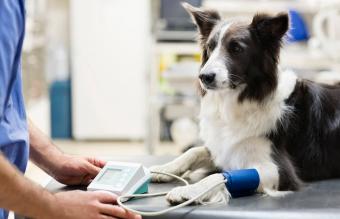
For some dog owners, learning how to check their dog's blood pressure is a necessary skill. There are several medical conditions where regular monitoring helps keep your dog healthy and provides much needed information for your veterinarian.
How to Take a Dog's Blood Pressure
When you first bring your dog to the veterinarian for a medical evaluation, they will test your dog's blood pressure using a cuff on their paw. Some veterinarians will put the cuff on the dog's tail. This cuff looks just like the ones your doctor uses to test your blood pressure, and in the same manner, they will inflate the cuff to increase the pressure on your dog's limb. Because dogs will initially be stressed during the procedure, it's common to take several measurements, with the first few deleted to account for the dog having higher blood pressure due to stress.
Doppler Vs Oscillometric Systems
There are two types of blood pressure monitoring devices that veterinarians commonly use. Both involve the use of the cuff around the dog's leg or tail. With the Doppler method, your veterinarian or technician will place a stethoscope on the dog's leg to listen for changes in the arteries during the inflation and deflation of the cuff. With an oscillometric system, nothing is placed on the dog's limb other than the cuff. Both methods have advantages and disadvantages for measurement and side effects and your veterinarian will decide which is the best for your dog's condition.
Using a Catheter
Some dogs will need to have their blood pressure measured by inserting a catheter which gives a more accurate reading, although it's an invasive procedure that is uncomfortable for the dog. This method is generally only used when a dog is in surgery or if they are in serious condition and their blood pressure needs to be monitored as part of their emergency treatment.
Taking Your Dog's Blood Pressure Step by Step
In order to take your dog's blood pressure at home, "there are automated kits that you can purchase," says Veterinarian Dr. Jeff Werber. Some examples of monitors available for purchase by pet owners are the Contec Automatic Blood Pressure Monitor and the Med Linket Automatic Veterinary Blood Pressure Monitor. "If you know where to put the cuff which can be on a leg, foot or the base of the tail, then it's not that hard to learn" how to check it at home.
- In order to take an accurate reading, your dog needs to be relaxed and calm.
- If your dog is anxious about the cuff or dislikes wearing it, work on getting him used to it before you actually use it to test his blood pressure.
- Let him wear it for about five minutes at a time and pair it with things he likes such as brushing, cuddling or giving him treats. If you're using treats, make sure your veterinarian approves of them as far as your dog's medical condition.
- Once your dog is comfortable wearing the cuff, find a quiet place for him such as on his bed or in his crate. You want some place where he'll be comfortable laying down on his side or on his belly for about 10 to 15 minutes.
- Place the cuff on one of his front legs and check his readings every few minutes for about 10 to 15 minutes. You want to get at least seven readings at a minimum.
- Take the measurements, delete the first two, and average the rest out to get your final reading.
- Record the measurements and make sure when you take them again that you have the dog in the same position and using the same leg so your data is consistent.
Using a Dog Blood Pressure Chart Download
It helps to have a spreadsheet ready to go to enter in your dog's measurements. Your veterinarian will also appreciate receiving a copy of a well-organized sheet. You can download the blood pressure chart printable using Adobe Reader and if you have Microsoft Excel, there's a version for that as well.


Normal Dog Blood Pressure
A normal healthy dog will have a blood pressure reading of around 150/95 or less. The number that your veterinarian will be most concerned with is the first number which is the systolic pressure which occurs when the heart passes blood into the body. The second number is called the diastolic pressure which occurs before the heart passes blood into the body. Dogs with systolic blood pressure of about 150 to 179 need medical intervention such as medication and additional diagnostic tests. A higher reading like 180 indicates the dog is in critical danger and needs veterinary care right away. Unlike in humans, veterinarians tend to only focus on the systolic pressure rather than both measurements.
Blood Pressure Chart
Blood pressure can vary a bit based on the equipment used to measure it, as well as by breed and obesity. "An overweight dog will probably have higher blood pressure," reports Dr. Werber. The following chart gives a range of blood pressure measurements.
| Blood Pressure Levels |
Systolic |
Diastolic |
| Normal |
90 to 159 mm Hg |
50 to 99 mm Hg |
| Visit Veterinarian |
160 to 179 mm Hg |
100 to 119 mm Hg |
| Dog in Critical Condition |
180 mm Hg plus |
120 mm Hg plus |

Symptoms of High Blood Pressure in Dogs
If you notice any of these symptoms, it's very possible your dog has high blood pressure. A veterinary checkup can help you determine if your dog needs medical intervention for the condition.
- Issues with the eyes are often the first sign that your dog has high blood pressure. This includes dilated pupils, rolling eyeballs, intraocular bleeding, hemorrhages, detached retinas or blindness.
- Problems with the kidneys including swelling or shrinking. There may also be protein or blood in the urine accompanied by excessive drinking, lack of appetite, lethargic behavior and chronic vomiting. You may also notice your dog urinating more than usual.
- Physical problems such as circling, weakness in the limbs or body, and disoriented behavior.
- Organ issues including heart murmurs, congestive heart failure and swollen thyroid glands. A common side effect of these conditions are coughing and difficulty breathing.
- Other symptoms include nosebleeds and in some cases seizures.
Medical Conditions Affecting Blood Pressure
Dogs with high blood pressure are actually dealing with a condition known as hypertension. Sometimes hypertension can be the main medical issue affecting the dog. Says Dr. Werber, in cases of primary hypertension, "it's usually not known what the cause is." In other cases, it can be a side effect related to other medical problems and is referred to as secondary hypertension. Some common illnesses that cause secondary hypertension are:
- Kidney disease
- Canine diabetes
- Obesity in dogs
- Hyperthyroidism
- Diseases of the endocrine system
- Cushing's disease
- Tumors in the kidneys
Breed Disposition and High Blood Pressure
Some types of sighthounds such as Greyhounds actually have a higher than normal blood pressure compared to other dog breeds. High blood pressure tends to show up more in the following breeds due to their risk of medical issues causing secondary hypertension:
- Australian Terriers (due to diabetes)
- Bichon Frises (due to diabetes)
- Dachshunds (due to Cushing's disease)
- Poodles (due to Cushing's disease
- Schnauzers (due to diabetes)
- Spitz breeds like Akitas, American Eskimo Dogs and Pomeranians (due to diabetes)
Monitoring Your Dog's Blood Pressure
Hypertension affects about 10% or less of dogs that are in good health and the risk increases with dogs suffering from conditions such as diabetes, renal failure and Cushing's disease. Learning how to monitor your dog's blood pressure at home can ensure that you can report to your vet your dog's progress and get him veterinary attention if your data indicates the need for medical intervention.







